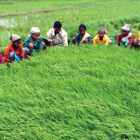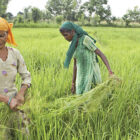The lockdown impacts different farming spaces differently and unless the bureaucracy consults the affected stakeholders the farm sector crisis will only deepen.
In the last quarter of 2019, things looked up for the Indian farmer as food prices were slowly creeping up. Dairy farmers were heaving a sigh of relief hoping to recoup the losses of the last three years. After two years milk prices had risen 30 per cent and stabilised at around Rs 35 per litre. Even prices for maize were at all record high of Rs 2,400 per quintal in December. Much before the government swung to action, social media posts about Wuhan’s wet markets trading in wild animals for domestic cooking went viral. In a nation easily swayed, people associating non-vegetarian food with the virus, started shunning chicken and eggs; demand started plummeting in December.
The ramifications of the lockdown did not sink in initially till supply lines choked up suddenly and farmers were left to fend for themselves and the buyers simply vanished. Eggs had to be thrown away, chicken allowed to die and be buried, cattle were half fed, perishables like oranges, grapes, mangoes, tomatoes, water melons and such others were left to rot in the field. Even where stocks were lifted, eggs sold at a depressing Rs1.50 down from Rs 4.50 per egg and milk was down to Rs 26 per litre. Maize prices have since fallen to Rs1,300. When the lockdown eases, prices are expected to dip further with the arrival of the fresh harvest in the largest maize markets of Purnea, Bihar.
Farmers, suffering losses are reluctant to invest and hence will plant a reduced acreage under perishables. Consequently, vegetable sowing is down in March and April, and expectedly will be in May too. Had it not been for the drastic reduction in household consumption of fresh fruit and vegetables over the last two months, inflation would have crept up and rendered the government powerless to respond. The good news is around the expected good monsoon that will significantly boost agriculture production. That is not an indicator or rural prosperity, as governments tend to project.
The lockdown has been eased and as public transportation resumes, the traumatised migrant labour, will rush back to security of their villages. An unprecedented six million plus have already registered for return, their trust eroded leaving them fatigued and restive. These migrants will not return easily to their place of work and much of their work may have even vanished. Each place will experience their own socio-economic churning; each will be troubling. While workplaces will face shortages of workers, other places like Uttar Pradesh, Bihar and Odisha will face a huge reverse migration from cities. This event has no precedent in India’s history and had a telling impact on the ground. The cost of transplanting paddy in Punjab is expected to rise from Rs 3,000 to more than Rs 6,000 per acre while daily wage rates in UP are falling from Rs 250 to Rs 150. Equally disturbing is that remittances that families received from migrants working in cities or in the middle east will drop significantly and millions of families across rural India that survived on them will be bereft of funds.
Evidently, a differentiated response will be needed for this crisis and the centre must provide the states with finances and the leeway to design state specific-programmes. Additionally, if only the states followed the central government notifications in letter and in spirit, would things normalise faster. The resolution of the crisis depends almost entirely on the levers controlled by the central government. Though the government should not be expected to identify and compensate individual farmers, nor does it have the capacity to do so, it can make interventions targeted at the poorest sections of society, which it hopefully will.
The worry is that the government is dithering over cash infusions into the economy and releasing foodgrain for those without documents. When the stimulus infuses modest amounts of cash into the hands of the people, consumption will not be broad based and the people may not react as expected. However, the demand for vegetables can recover much faster, while the supply will not be able to keep pace and the deflation in farm gate prices can turn inflationary for consumers very fast, when it happens.
In a nation recovering from the pangs of endogenous policy shocks of the past, the exogenous pandemic tipped an economy into a free fall, when it was least prepared. An economic stimulus only provides a breather but a longer-term recovery will depend more on the PMO pushing for meticulous reforms and seemingly tedious improvements in governance. Both will be skilfully resisted by the entrenched system. The urge to only announce grandstanding big-ticket reforms (agriculture is a state subject) must be checked as these are not the final solution, as usually made out to be.
In their book, ‘Radical Uncertainty’, John Kay and Mervyn King write that effective leaders understand that they have “superior responsibility” rather than “superior wisdom”. To ensure positive outcomes, stakeholders for whom the reforms are intended, should be part of the process to decide strategy and design. It is not as simple as it sounds; the ministries genuinely believe they know better and have rolled out innumerable programmes over the last two decades to end the farm crisis. They have not succeeded. The only thing that has increased are farmer suicides.




